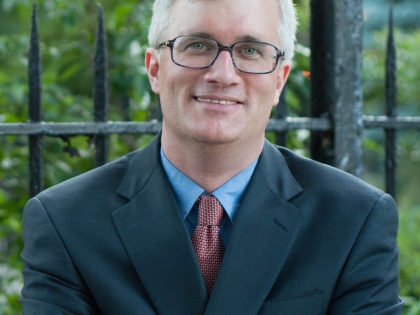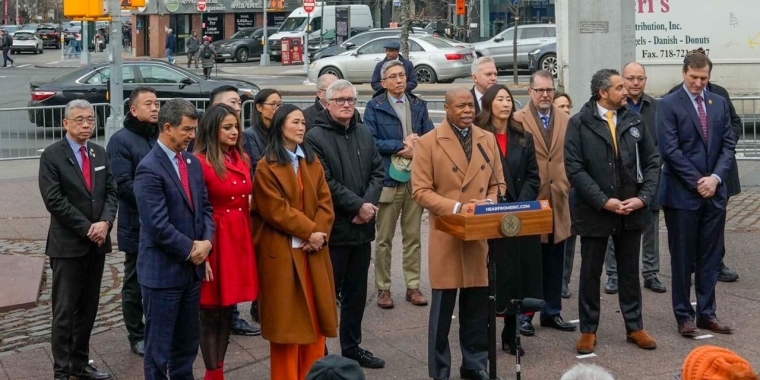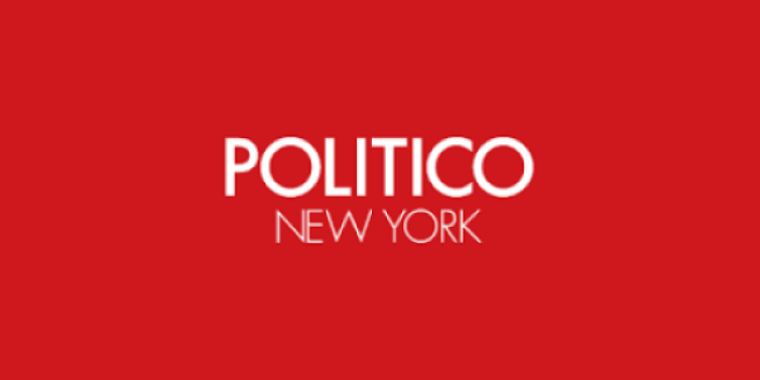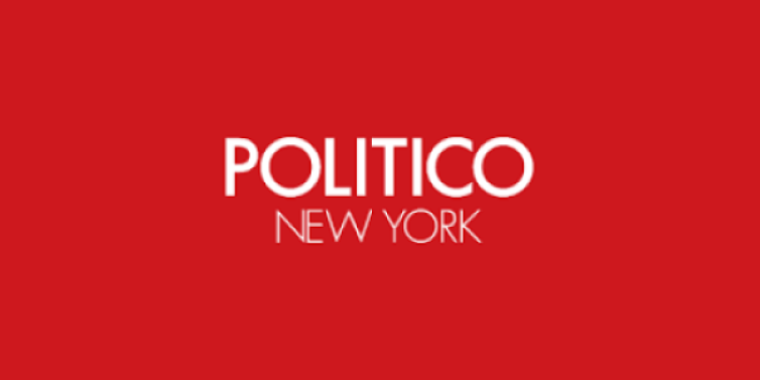
Mayor Adams Launches "Chinatown Connections" Plan to add new Public Space and Improve Traffic Safety in Chinatown
February 13, 2024

Senator Kavanagh joins Mayor Adams and community leaders to announce Chinatown Connections
NEW YORK – New York City Mayor Eric Adams today launched “Chinatown Connections,” a joint city and state investment that will dramatically improve the public space in Chinatown through redesigning Park Row and Chatham/Kimlau Square — making the area safer, more-pedestrian friendly, and more welcoming to both residents and visitors. “Chinatown Connections” will bring together $44.3 million in city capital funding with $11.5 million from New York state’s Downtown Revitalization Initiative awards for a total project budget of $56 million. Building on an announcement in Mayor Adams’ State of the City address last month, “Chinatown Connections” furthers the Adams administration’s commitment to enhancing and expanding public space across the city.
“For far too long, Chinatown residents, neighbors, and tourists alike had to deal with confined public spaces and dangerous intersections at Chatham/Kimlau Square, but those days are coming to a close. Our $56 million joint investment with the state in ‘Chinatown Connections’ will allow us to reimagine the square with shortened street crossings, more public space, simpler intersections, and direct cyclist connections — making our streets even safer for all New Yorkers to share,” said Mayor Adams. “We’ll beautify Park Row, making it easier for New Yorkers and tourists to get from the foot of the Brooklyn Bridge to Chinatown and all the small businesses here, and we’ll give Chinatown the entrance it deserves with a new Welcome Gateway that honors this neighborhood’s rich cultural heritage. At every step of the way, we will work hand-in-hand with the local Chinatown community so that the project reflects what the community wants and needs from our city. This announcement is another step in our work to revitalize the future of Chinatown and reimagine the urban experience for all New Yorkers.”
“The state is not only committed to preserving the culture of the community but also investing in projects that enhance the livability, health and prosperity of communities to benefit residents, businesses, and tourists alike,” said Secretary of State Robert J. Rodriguez. “Today we celebrate the launch of three signature Chinatown Downtown Revitalization Initiative projects that together will re-envision Kimlau Square as a safe and attractive community destination, celebrate Chinatown’s local culture, and invite visitors back to Chinatown’s local restaurants and businesses. We thank Mayor Eric Adams for working together with the state and community and for investing an additional $44.3 million towards these key undertakings. I am confident these, now enhanced projects, along with the other eight DRI funded community projects, will ensure local residents witness a greater beneficial neighborhood impact.”
Reimagining Chatham/Kimlau Square
Currently, Chatham/Kimlau Square features a five-point intersection with complex traffic movements; this results in many conflict points, which endanger drivers, cyclists, and pedestrians. This year, in consultation with the local Chinatown community, the administration will kick off a traffic study to inform redesigning Chatham/Kimlau Square to create a standard, four-way intersection, larger public space, shorter pedestrian crossings, and direct cyclist connections. The study will also evaluate the option of either keeping Park Row closed to private car traffic or reopening Park Row in the future with a redesigned Kimlau Square. The study will take into consideration both existing traffic conditions and future traffic conditions under congestion pricing. Following that study and a community engagement process, construction is scheduled to begin in 2027, with estimated completion in 2029. Approximately $5 million of the $11.5 million Downtown Revitalization Initiative award will go towards this redesign.
Beautifying the Park Row Connection to Chinatown
Park Row is a critical pedestrian and bike route connecting Lower Manhattan, Chinatown, the Brooklyn Bridge, and the new public space at the Brooklyn Bridge Arches. Starting this spring, the city will launch a Street Improvement Project on the Park Row connection to Chinatown, between Frankfort Street and Chatham/Kimlau Square. In consultation with the local community, the city will implement short-term improvements to enhance the pedestrian and bicyclist experience, including safety improvements, art interventions, new planters, and additional wayfinding and signage. In parallel, the city will engage with the local community to evaluate options for deploying $4 million of the $11.5 million Downtown Revitalization Initiative award for permanent improvements on Park Row. The project will begin with a community engagement period, and construction work will commence in 2024, with short-term improvements being installed throughout the year.
Creating a Chinatown Welcome Gateway
The city will also build a Chinatown Welcome Gateway, located in the vicinity of Chatham/Kimlau Square, finally giving one of New York City’s most historic districts the entrance it deserves. The Chinatown Welcome Gateway will commemorate the cultural heritage of the neighborhood and draw visitors to local businesses. The location, size, and design of the gateway will be informed by the traffic study, existing conditions assessment, and robust community engagement. The construction timeline for the Chinatown Welcome Gateway will depend on private fundraising to supplement $2.5 million of the $11.5 million Downtown Revitalization Initiative award.
This month, the city will convene a community working group of key stakeholders across Chinatown sectors to help guide the entire project design and implementation. The community working group is expected to convene at key milestones throughout an 18-month engagement process, and the public engagement process will expand to community board presentations and broader public meetings. These efforts build on three initial public workshops the city conducted with the Chinatown community last year.
“Since the beginning of this administration, we have been committed to making Chinatown a more livable, walkable community, with more and better public spaces for residents and visitors,” said Deputy Mayor for Operations Meera Joshi. “From the Arches to Kimlau Square, we are working closely with local leaders and residents to ensure that these public spaces are by and for residents — prioritizing safety, comfort, and connection. With deep thanks to our state partners, we look forward to continuing our robust public outreach and delivering an exciting new public space for Chinatown.”
“‘Chinatown Connections’ advances the administration’s commitment to celebrating this area’s cultural heritage while making significant public safety and infrastructure investments benefitting its residents, small businesses, and visitors,” said Deputy Mayor for Housing, Economic Development, and Workforce Maria Torres-Springer. “Similar to our other neighborhood planning efforts, we are excited to kick off this work with a comprehensive, community-focused engagement process that will deliver transformative improvements to Kimlau Square.”
“‘Chinatown Connections’ is a city and state collaboration that will bring dramatic public realm improvements to Chinatown and public safety improvements to one of the busiest intersections in Manhattan,” said New York City Economic Development Corporation President & CEO Andrew Kimball. “Reimagining public spaces with pedestrian safety and outdoor amenities continues to be a top priority for the Adams administration, and we are looking forward to working with DOT and NYC Parks to revitalize this culturally significant area of Manhattan.”
“The ‘Chinatown Connections’ project exemplifies the city’s dedication to fostering equitable streets and welcoming public spaces in our effort to reimagine the public realm for years to come,” said New York City Department of Transportation (DOT) Commissioner Ydanis Rodriguez. “This ambitious project aims to revitalize busy neighborhood areas, including Park Row, Chatham Square, and Kimlau Plaza, improving the overall pedestrian experience, creating new bicycle connections, and dramatically enhancing street safety and connectivity at a major Manhattan crossing. I am pleased DOT was able to allocate $44 million in support of the effort to deliver this project, and I look forward to continued collaboration with the community, as well as our city and state agency partners, to further enrich Chinatown.”
“We are thrilled to participate in ‘Chinatown Connections,’ an inter-agency collaboration that aligns with the Adams administration’s commitment to enhance and expand public spaces,” said New York City Department of Parks and Recreation (NYC Parks) Commissioner Sue Donoghue. “This effort is designed to increase open spaces, create safer walkways, and redirect traffic to better safeguard pedestrians. We thrive on collaboration, involving community residents to be a part of projects such as this one at Kimlau Square, which will honor the rich cultural heritage of the Chinatown neighborhood. Through this project, our agencies are committed to ensuring safety, enhancing the aesthetics of the space, and supporting community events to bring visitors to the heart of Chinatown — through the beautification of Park Row and the redesign of Kimlau Square.”
“Public space is a not a luxury, but a necessity for all communities throughout the city,” said Chief Public Realm Officer Ya-Ting Liu. “Today, the Adams administration is making an unprecedented investment to transform public space in Chinatown that will not only improve traffic safety and create a vibrant space for local residents that honors the history and cultural fabric of the neighborhood, but that will make Kimlau Square a destination for visitors to enjoy and experience what the many wonderful local businesses have to offer.”
“More public realm enhancements like this mean greater neighborhood vitality and safety for residents and visitors across the city,” said “New” New York Executive Director B.J. Jones. “The partnership between the city, state, and community leaders makes this gateway a testament to our joint commitment to make the necessary investments to fuel New York’s economic resurgence.”
NYCEDC will be the lead agency responsible for the procurement, engagement, design, and construction processes. Additionally, NYCEDC will coordinate between NYC Parks, DOT, and the New York City Department of Cultural Affairs (DCLA). NYC Parks will lead the Memorial Arch restoration and DOT will lead the Park Row improvements and the new Kimlau intersection, plaza, and gateway. DCLA will facilitate the artist selection process for the Chinatown Welcome Gateway.
Understanding that public spaces are where communities are built, culture is fostered, and opportunities are created, Mayor Adams committed $375 million to creating new, vibrant public spaces in his 2023 State of the City address. To further that effort, he appointed Ya-Ting Liu as the city’s first-ever chief public realm officer and launched visionary projects in all five boroughs to create new public spaces, including the North Shore of Staten Island, Broadway Vision and Fifth Avenue in Manhattan, Broadway Junction in Brooklyn, the Met Hub in Queens, and new, world-class skateparks in the Bronx and Brooklyn. Mayor Adams also signed the country’s largest permanent outdoor dining program into law last year to create better, cleaner, and more accessible sidewalk and roadway cafes and significantly expanded open street programs during the holiday and summer seasons.
To keep the city’s public spaces clean and transform what it feels like to be outside in New York City, Mayor Adams and New York City Department of Sanitation (DSNY) Commissioner Jessica Tisch launched efforts to containerize 100 percent of businesses’ trash and all residential trash from buildings with nine or fewer units. Building on the progress made over the course of the past two years, last week, the city unveiled a new, automated, side-loading garbage truck and a new data-driven containerization strategy in the city’s next phase of its war on black trash bags. The city will expand its Harlem on-street containerization pilot and take steps to get every single black trash bag off of New York City streets.
“I am thrilled to see the city, state and the Chinatown community come together to transform Park Row and Kimlau Square,” said U.S. Representative Dan Goldman. “Manhattan’s Historic Chinatown is one of the oldest and most important Chinese-American communities in America and has long been a hub of cultural and economic activities. I am proud to see that the city is moving forward with this crucial investment to help revitalize this long-overlooked neighborhood. I look forward to working with the mayor, my fellow elected officials, government agencies, and the community to ensure an equitable and inclusive revitalization of Chinatown.”
“I am proud to have joined with this community in securing the largest State Downtown Revitalization Initiative grant ever, to support transformative projects like Chinatown Connections,” said New York State Senator Brian Kavanagh. “This project will dramatically improve the public space in Chinatown in the form of a redesigned Park Row and Chatham/Kimlau Square — making the area safer, more-pedestrian friendly, and more welcoming, and helping strengthen the economic and social fabric of our Chinatown neighborhood. I thank Mayor Adams, Secretary of State Rodriguez, Borough President Levine, Assemblymember Lee, Councilmember Marte, Congressman Goldman, Wellington Chen, Raymond Tsang and everyone from this community for the collaborative spirit that it takes to conceptualize a project like this, and move forward in such an iconic, heavily trafficked public space.”
“I am proud to partner with the city of New York to lift up Manhattan’s Chinatown,” said New York State Assemblymember Jenifer Rajkumar. “I have dedicated my career to empowering New York’s immigrant communities. From Kimlau Square to Confucius Plaza, Chinatown is a treasure that exemplifies the vibrancy of the Chinese American community in our Gorgeous Mosaic. Last year, I made history with my Albany colleagues when we established Lunar New Year as a statewide school holiday. Mayor Adams' ‘Chinatown Connections’ plan takes the next step in serving New York’s Chinese-American community by investing $56 million to revitalize public space in Chinatown. Today, we commit to revitalizing Kimlau Square and Park Row helping them become safe, pedestrian friendly spaces. I am proud to help beautify and renew public spaces across our city.”
“I thank Mayor Adams and Governor Hochul for bringing these vital investments to our Chinatown community,” said New York State Assemblymember Grace Lee. “Despite being one of the most historic neighborhoods in New York City, Chinatown has a long history of being underfunded and underserved; projects like this show we are finally starting to receive the support and recognition we deserve. I look forward to seeing the impact these revitalized spaces have on our community and to continue working with Mayor Adams and Governor Hochul to address the needs of Asian New Yorkers.”
New York State Assemblymember Lester Chang said: “I am grateful to Governor Hochul, Mayor Adams and former Manhattan Borough President Gale Brewer for having allocated funding to develop much needed renovations at Kimlau Chatham Square. This has been under development since 9/11 from the closing of Park Row traffic. I hope that this new investment will energize the local business community and bring much needed attention thereto.”
“This development of Chinatown’s public spaces and pedestrian infrastructure will honor the community’s past and invest in its future. As a bonus, the Kimlau Square redesign will attract more tourists and their dollars to the neighborhood, which is still struggling to recover from the deep losses brought on by the pandemic,” said Manhattan Borough President Mark Levine. “I encourage everyone in Chinatown to participate in the public engagement process and help shape the outcome.”
“The Chinatown connections project is a visionary project aimed at addressing the many issues in our community that have affected pedestrians and vehicles for all too long,” said Raymond Tsang, president, Chinese Consolidated Benevolent Association. “With this project going forward from the support of the city and state government, our community will benefit from the improved traffic and pedestrian safety that it brings, and the tourists from near and far, to admire what a revitalized Chinatown has to offer.”
“Kimlau Square has historically been an important place — for open air markets or for the public to use the elevated train station,” said Wellington Chen, executive director, Chinatown Partnership. “It is also where we remember the veterans and honor those who served and paid the ultimate sacrifice as it is the vital key connection where streets converge. We look forward to having a better and proper setting for future commemorations and communal gatherings for generations to come.”
“Community Board 3 is very excited to plan for the renovation of historic Kimlau Square,” said Andrea Gordillo, chair, Manhattan Community Board 3. “The renovation of this gateway to Chinatown will make a great impact every day on the safety of pedestrians and bicyclists, and improve and enlarge the public space used by many Chinatown residents. Community members have long requested that the intersection be redesigned and aligned so residents can cross safely. The pathway from Park Row to the Brooklyn Bridge will unify the neighborhood and encourage the flow of residential traffic through a beautified and accessible street.”
“Today, we stand at the threshold of a new era for Chinatown and Lower Manhattan, united in our efforts to foster a safer, more connected and vibrant urban landscape,” said Tammy Meltzer, chair, Manhattan Community Board 1. “This project will do more than just enhance the function and aesthetics of our city streets. It serves as a profound act of reconnection and healing, beginning to knit back together a divide that tore apart the very fabric of our communities on 9/11. A vital part of that reconnection is creating space for community stakeholders for those who live, work, study and visit the area. The commitment for an inclusive community outreach process initiated by the city, signals a future crafted in collaboration with these important neighborhoods, ensuring that local voices and visions shape the path forward. I thank the vital community leaders who have moved this project forward, and Mayor Adams and Governor Hochul for investing in their vision. Together, we are not just redesigning a square that honors Chinese-American soldiers who lost their lives defending the United States; we are redefining the future.”
“We’re really excited to see investment in quality public space in Chinatown, especially in a major gateway to the neighborhood,” said Emily Jacobi, Manhattan organizer, Transportation Alternatives. “We know pedestrianization is a win for everyone — making our streets safer, our businesses thrive, and our communities stronger — and we hope to see more pedestrianization projects spread equitably across the neighborhood. Chinatown has some of the lowest car ownership rates in New York City, and we hope to see serious improvements all the way through Chinatown from Kimlau Square through Canal Street — the most dangerous street in the borough for pedestrians and a main connector into the neighborhood.”
About the Downtown Revitalization Initiative
Chinatown was the winner of round five of New York state’s Downtown Revitalization Initiative, a cornerstone of its economic development program, which transforms downtown neighborhoods into vibrant centers that offer a high-quality of life and are magnets for redevelopment, business, job creation, and economic and housing diversity. Led by the New York Department of State, with assistance from Empire State Development, Homes and Community Renewal, and the New York state Energy Research and Development Agency, the Downtown Revitalization Initiative represents an unprecedented and innovative “plan-then-act” strategy that couples strategic planning with immediate implementation and results in compact, walkable downtowns that are a key ingredient to helping New York state rebuild its economy from the effects of the COVID-19 pandemic, as well as to achieving the state’s bold climate goals by promoting the use of public transit and reducing dependence on private vehicles.
In the first six years of the program, the state committed $700 million investing in 69 downtowns ripe for revitalization. Participating communities are nominated by the state’s 10 Regional Economic Development Councils based on the downtown’s potential for transformation. Each community is awarded $10 million to develop a downtown strategic investment plan and implement key catalytic projects that advance the community's vision for revitalization and leverage additional private and public investments. More information on the Downtown Revitalization Initiative is available online.
###
Share this Article or Press Release
Newsroom
Go to NewsroomState of Politics: Senate Democrats Push Gun Control Package
February 6, 2018

Politico NY: Senate Democrats Push for Gun Bills
February 6, 2018


